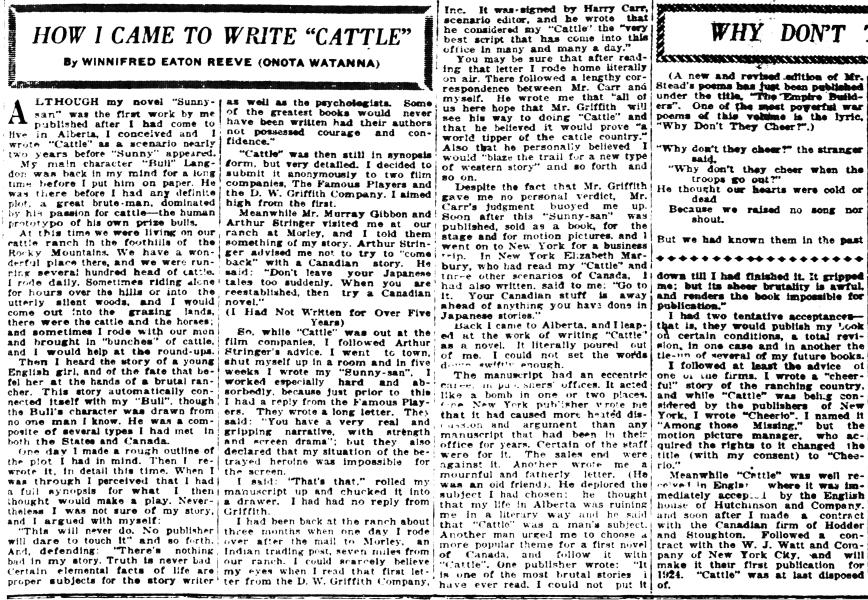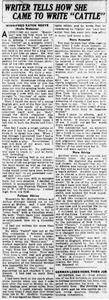Although my novel “Sunny-san” was the first work by me published after I had
come to live in Alberta, I conceived and I wrote “Cattle” as a scenario nearly
two years before “Sunny” appeared.
My main character “Bull” Langdon was back in my mind for a long time before I
put him on paper. He was there before I had any definite plot, a great brute-man,
dominated by his passion for cattle—the human prototype of his own prize bulls.
At this time we were living on our cattle ranch in the foothills of the Rocky
Mountains. We have a wonderful place there, and we were running several hundred head
of cattle. I rode daily. Sometimes riding alone for hours over the hills or into the
utterly silent woods, and I would come out into the grazing lands, there were the
cattle and the horses; and sometimes I rode with our man and brought in
“bunches” of cattle, and I would help at the round-ups.
Then I heard the story of a young English girl, and of the fate that
befell
her at the hands of a brutal rancher. This story automatically connected
itself with my “Bull,” though the Bull’s character was drawn from no one man I
know. He was a composite of several types I had met in both the States and Canada.
One day I made a rough outline of the plot I had in mind. Then I rewrote it, in
detail this time. When I was through I perceived that I had a full synopsis for what
I then thought would make a play. Nevertheless I was not sure of my story, and I
argued with myself:
“This will never do. No publisher will dare to touch it” and so forth. And,
defending:
“There’s nothing bad in my story. Truth is never bad.1 Certain
elemental facts of life are proper subjects for the story writer as well as the
psychologists. Some of the greatest books would never have been written had their
authors not possessed courage and confidence.”
“Cattle” was then still in synopsis form, but very detailed. I decided to submit
it anonymously to two film companies. The Famous Players and the D. W. Griffith
Company. I aimed high from the first.
Meanwhile Mr. Murry Gibbon and Arthur Stringer visited me at out ranch at Morley, and
I told them something of my story. Arthur Stringer advised me not to try to “come
back” with a Canadian story. He said: “Don’t leave your Japanese tales too
suddenly. When you are reestablished, then try a Canadian novel.”
(I Had Not Written for Over Five Years)
So, while “Cattle” was out at the film companies, I followed Arthur Stringer’s
advice. I went to town, shut myself up in a room and in five weeks I wrote my
“Sunny-san.” I worked especially hard and absorbedly, because just prior to
this I had a reply from the Famous Players. They wrote a long letter. They said:
“You have a very real and gripping narrative, with strength and screen
drama”; but they also declared that my situation of the betrayed heroine was
impossible for the screen.
I said: “That’s that,” rolled my manuscript up and chucked it into a drawer. I
had had no reply from Griffith.
I had been back at the ranch about three months when one day I rode over after the
mail to Morley, an Indian trading post, seven miles from our ranch. I could scarcely
believe my eyes when I read that first letter from the D. W. Griffith Company, Inc.
it was signed by Harry Carr, scenario editor, and he wrote that he considered my
“Cattle” the “very best script that has come into this office in many and
many a day.”
You may be sure that after reading that letter I rode home literally on air. He wrote
me that
“all of us here hope that Mr. Griffith will see his way to doing
‘Cattle’2 and that he believed it would prove ‘a world tipper of the
cattle country’3.” Also that he personally believed I would
“blaze the
trail for a new type of western story” and so forth and so on.
Despite the fact that Mr. Griffith gave me no personal verdict, Mr. Carr’s judgement buoyed
me up. Soon after this “Sunny-san” was published, sold as a book, for the stage and
for motion pictures, and I went on to New York for a business trip. In New York Elizabeth
Marbury, who had read my “Cattle” and three other scenarios of Canada, I had also
written, said to me: “Go to it. Your Canadian stuff is away ahead of anything you have
done in Japanese stories.”
Back I came to Alberta, and I leaped at the work of writing “Cattle” as a novel.
It literally poured out of me. I could not set the words down swiftly enough.
The manuscript had an eccentric career in publishers’ offices. It acted like a bomb
in one or two places. One New York publisher wrote me that it had caused more heated
discussion and argument than any manuscript that had been in their office for years.
Certain of the staff were for it. The sales end were against it. Another wrote me a
mournful and fatherly letter. (He was an old friend). He deplored the subject I had
chosen: he thought that my life in Alberta was ruining me in a literary way and he
said that “Cattle” was a man’s subject. Another man urged me to choose a more
popular theme for a first novel of Canada, and follow it with “Cattle.” One
publisher wrote: “It is one of the most brutal stories I have ever read. I could
not put it down till I had finished it. It gripped me; but its sheer brutality is
awful, and renders the book impossible for publication.”
I had two tentative acceptances—that is, they would publish my book on certain
conditions, a total revision, in one case and in another the tie-up of several of my
future books.
I followed at least the advice of one of the firms. I wrote a “cheerful” story
of the ranching country, and while “Cattle” was being considered by the
publishers of New York, I wrote “Cheerio.” I named it “Among those
Missing,” but the motion picture manager, who acquired the rights to it changed
the title (with my consent) to “Cheerio.”
Meanwhile “Cattle” was well received in England where it was immediately
accepted by the English house of Hutchinson and Company, and soon after I made a
contract with the Canadian firm of Hodder and Stoughton. Followed a contract with the
W. J. Watt and Company of New York City, and will make it their first publication for
1924. “Cattle” was at last disposed of.

